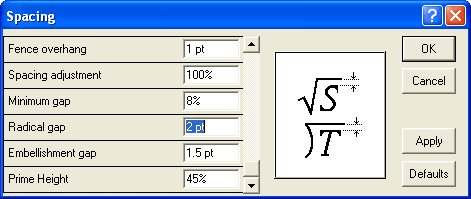Written by Allen Wyatt (last updated September 29, 2018)
This tip applies to Word 97, 2000, 2002, and 2003
A radical is often referred to as a "square root symbol," when, in fact, it is used for any types of roots (square, cubed, and so on). The Equation Editor allows you to specify a distance between the top of the radical and the top of any characters under the radical. You do this as follows:

Figure 1. The Spacing dialog box.
WordTips is your source for cost-effective Microsoft Word training. (Microsoft Word is the most popular word processing software in the world.) This tip (941) applies to Microsoft Word 97, 2000, 2002, and 2003.

Create Custom Apps with VBA! Discover how to extend the capabilities of Office 365 applications with VBA programming. Written in clear terms and understandable language, the book includes systematic tutorials and contains both intermediate and advanced content for experienced VB developers. Designed to be comprehensive, the book addresses not just one Office application, but the entire Office suite. Check out Mastering VBA for Microsoft Office 365 today!
The Equation Editor is a handy tool, particularly for those who must include mathematical equations in their documents. ...
Discover MoreThe equation editor is a great tool for adding mathematical equations into your document. The placement of many elements ...
Discover MoreThe Equation Editor provided with Word can be very powerful in how it displays mathematic equations. Here's how you can ...
Discover MoreFREE SERVICE: Get tips like this every week in WordTips, a free productivity newsletter. Enter your address and click "Subscribe."
There are currently no comments for this tip. (Be the first to leave your comment—just use the simple form above!)
Got a version of Word that uses the menu interface (Word 97, Word 2000, Word 2002, or Word 2003)? This site is for you! If you use a later version of Word, visit our WordTips site focusing on the ribbon interface.
Visit the WordTips channel on YouTube
FREE SERVICE: Get tips like this every week in WordTips, a free productivity newsletter. Enter your address and click "Subscribe."
Copyright © 2026 Sharon Parq Associates, Inc.
Comments